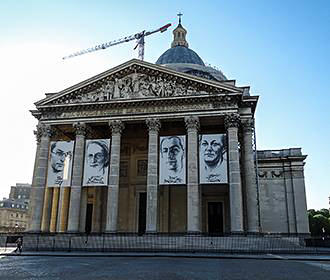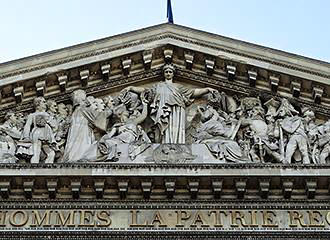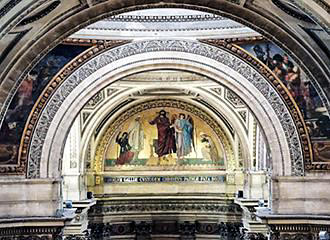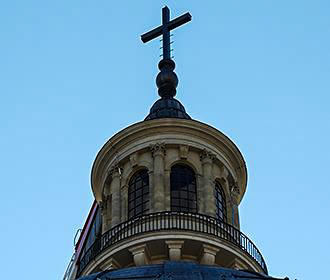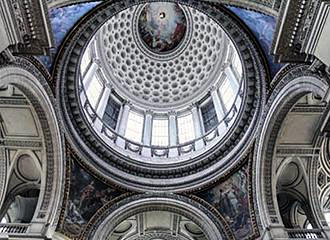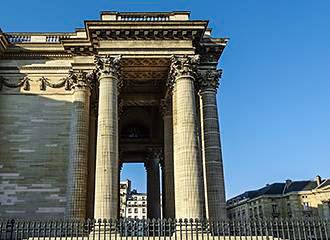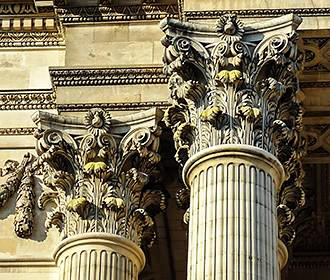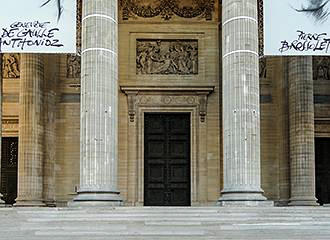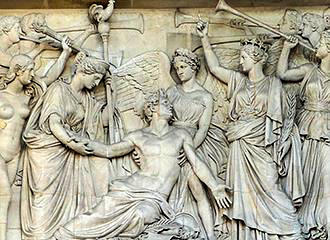The Pantheon in Paris
Originally this was designed as a church that would be dedicated to Saint Genevieve, the church was meant to replace the ruined church where one had always stood for hundreds of years, but it then became a place for great men to be buried and turned into the Pantheon, which is one of the great monuments in Paris that we all can still visit today.
But the history of the Pantheon is far more than that, right through from its construction, to the famous people buried here like Victor Hugo, Voltaire, Marie Curie and many more, yet alone the architecture and building itself, through to the installation of the Foucoult’s pendulum.
Visiting The Pantheon monument in Paris
You can discover the masterpiece in architecture from the architect Soufflot while you are on holiday in Paris, and by entering this monument you can get to see the Foucoult’s pendulum and the crypt, which has a permanent exhibition that provides details of the work and lives of those that are buried here.
Plus you can have a guided tour of the dome and the external colonnade that provides fabulous views of Paris from its elevated position in the city and much more, but below are just some of these points you can experience in more detail.
The main floor of the Pantheon
On the main floor from the entrance to the nave and onward, you will be able to see a huge central space that is emphasised by rows of Corinthian style columns that are located on each side of the aisle. But there are also thick pillars that support the weight of the impressive dome above.
Right in the centre of the cross shaped Pantheon hanging from the Dome, you can also get to see a replica of Leon Foucault’s Pendulum that was first installed back in 1851 as a science experiment to demonstrate the rotation of the earth. And this particular replica of the ball was installed in 1995.
There is of course a vast amount to see on the main floor of the Pantheon, including sculptures from the early 20th century, which are at the base of the pillars that support the dome and these depict subjects from the French Revolution.
And as you walk from the front, where the ticket office and gift shop are located, past the pendulum to the back of the Pantheon, you will see the staircase that leads down to the crypt, which is where many famous people are now interred.
You can also get to see the maroufles, which are basically paintings on canvas that are glued in place, and these are located where the original windows were bricked up during the French Revolution and depict the life of Saint Genevieve, the beginnings of Christianity and the beginnings of the monarchy in France.
The crypt of the Pantheon in Paris
The first thing you are likely to see as you go down to the crypt, is the urn that holds the heart of Leon Gambetta that was brought to the Pantheon in 1920 as a reminder of the person who founded the Third republic.
The first section of the crypt, known as the vestibule holds the tombs of Voltaire with a statue of Voltaire in front of his tomb and a statue shaped like a rustic temple in front of Rousseau’s tomb, and these are located opposite each other, as they were both considered to be symbols of the Enlightenment.
And in the same area, the tomb of Jacques Soufflot, who was the architect of the Pantheon commissioned during the reign of King Louis XV was added in 1829.
The western arm of the Pantheon
Looking to the right of the Western arm and in the first vaults after the rotunda, you will be able to see that there were 41 dignitaries of the Empire buried here by order of the Emperor, Napoleon Bonaparte I and a couple of these men included Tronchet and Portalis.
Then to the left of the Western arm of the Pantheon, you will see Victor Schoelcher, who fought for to abolish slavery throughout the world, was originally buried in the Pere Lachaise Cemetery and then transferred to the Pantheon on the centenary of the abolition of slavery.
Also buried next to Victor Schoelcher you can fing Jean Jaures, who was the father of French socialism and Felix Eboue, who was the first overseas French Resistance fighter, plus the tombs of writers Victor Hugo and Emile Zola, can also be found in this part of the crypt.
The remains of other famous people have also been moved to this part of the Pantheon in order to commemorate the centenary of the revolution and they lie in front of the grave of Jean Lannes, Marechal de France who was admired and respected by Napoleon Bonaparte.
Also, when you look at the history of the Pantheon, far more recently and in fact only in 2002, the remains of Alexandre Dumas who was the author of The Three Musketeers, is now buried in the same area.
The northern arm of the Pantheon
There are some incredibly famous people buried in the vaults of the northern arm of the Pantheon and these include Jean Moulin, who was a French Resistance fighter and hero, and today there is even one of the museums in Paris that is dedicated to Jean Moulin who was classed as the leader of the French resistance.
Another person interred here is Rene Cassin, who was the main author of the Universal Declaration of Human Rights that was adopted by the UN in 1948, along with Jean Monnet, who was a founder of the European Community.
The next vault along in the Northern arm of the Pantheon are the remains of those that were buried on the bicentenary of the French Revolution and then further along again, there are the tombs of Pierre and Marie Curie for their scientific research and work on the study of radium and she was the first woman to be interred in the Pantheon on her own merits of what she had achieved.
Yet today, many people will have heard of Marie Curie, purely through being touched by cancer, and for those of you that are interested in the science and how combating cancer progressed from her original work, then a visit to Musee Curie museum in Paris is also a must.
Accessing the Pantheon monument in Paris
Located on the Montagne Saint-Genevieve in the 5th Arrondissement of Paris in the Latin Quarter, which is also home to the botanical gardens called the Jardin des Plantes, the Pantheon is accessed on the Western façade via a monumental peristyle that was originally inspired by a pantheon in Rome. However, there have actually been four different pediments, since the building was first constructed and the most recent one dates from 1837.
The Dome itself can be accessed during the months of April through to October and this is the way you can also access the external colonnade at the base of the dome, which will provide some fabulous views of Paris. However, access to the dome and the colonnade is only available via a guided tour and there is a maximum of 50 people allowed at any one time.
However, the Pantheon itself is open all year round, except on French holidays such as 25th December, 1st January and 1st May. From the start of October through to the end of March, it is open from 10am to 6pm and on all other dates it closes at 6.30pm, but we would like to point out that last admission is a minimum of 45 minutes before closing time, and this is for an unaccompanied visit.
The unaccompanied visit is a cost of €9 as of 2012, but people under the age of 18 are admitted free if accompanied by an adult, yet disabled people also get free admission as well. Plus with this entrance fee you get a guide booklet that is available in different languages that includes French, German, English, Spanish, Italian, Russian, Portuguese and Chinese.
A guided visit for an individual is only on reservation and needs to be booked at least one month of more in advance, and at present it appears that this is in the French language only, but there are also specific tours arranged for the hearing or sight impaired and again these need to be booked in advance.
Lecture visits are also possible and are available on set days and times and these are available in French, English and Spanish, plus you can also make group reservations along with conferences that are a cost of €15 per person as of 2012.
The closest Metro Stations are either the Cardinal Lemoine stop or the Place Monge station, yet if you are travelling on the RER, then this would be line B and the Luxembourg stop by the Luxembourg Gardens.
